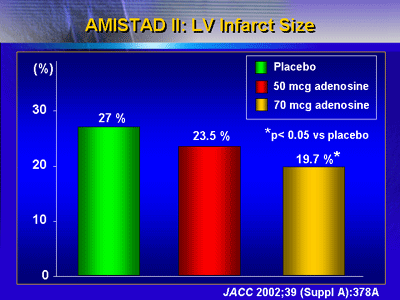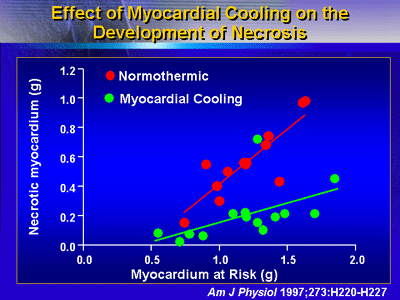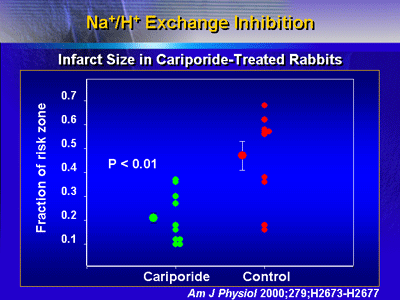|
In the future, patients undergoing early
reperfusion for acute myocardial infarction may receive adjunctive
therapies to further reduce infarct size. Promising adjunctive
therapies under study include intravenous beta-blockers, glucose-insulin-potassium,
adenosine, hypothermia, sodium/hydrogen exchange inhibitors,
magnesium and ATP-sensitive potassium channel (K ATP) openers. Today,
the most important treatment for protection of ischemic myocardium
is early reperfusion therapy. This involves opening the occluded
vessel quickly and keeping it open. Important modalities include
thrombolysis, percutaneous coronary interventions including
angioplasty and stenting, aspirin, heparin, and GP IIb/IIIa
inhibitors.
Dr. Kloner and colleagues are studying modalities
that may improve upon reperfusion alone. To date, researchers
have studied a number of pharmacologic interventions for this
purpose. Many of them have failed. These include white blood
cell inhibitors, oxygen radical scavengers and complement
inhibitors. Studies in the medical literature show negative
outcomes for these agents.
Adjunctive Therapies that
have failed to
Reduce Infarct Size or Improve Outcome
| Inhibitors
of WBC adhesion |
HALT MI, LIMIT MI |
No reduction in IS |
| Calcium
blockers (Nifedipine) |
SPRINT-2 |
Increased mortality |
| h-SOD |
Flaherty JT, et al. Circulation 1994;89:1982 |
No increase in LV function |
| RheothRx
(poloxamer 188) |
CORE Study |
No difference in death, shock or re-infarction |
| Trimetazidine
(antioxidant) |
EMIP-FR |
No effect on mortality |
| Molsidomine
(nitric oxide donor) |
ESPRIM |
No effect on mortality or other clinical outcome |
| Fluosol |
TAMI-9 |
No reduction in infarct size or improvement
in LV function |
| Hyaluronidase |
Pre-thrombolytic era |
No effect on infarct size |
| Complement
Inhibition |
COMPLY Trial |
Complement activity blocked but no reduction
in infarct size |
|
However, there have been some positive studies
in the medical literature. For example, some investigations
have focused on early intravenous beta-blockade for acute
myocardial infarction. A number of these trials suggest that
early beta-blockade, within the first 3 to 5 hours of acute
myocardial infarction, will reduce infarct size, improve left
ventricular function and reduce reinfarction rates. Some studies
suggest this approach may even improve survival.
Another area of interest is glucose-insulin-potassium.
In one recent trial including patients with diabetes mellitus
and acute myocardial infarction, this therapy reduced 1-year
mortality (18.6% versus 26.1% in control, p = 0.03). This
difference persisted and remained significantly improved at
3.4 years. The effect was most evident in patients who were
at low cardiovascular risk and had not received previous insulin
treatment. In another study of glucose-insulin-potassium in
acute myocardial infarction, there was a significant difference
in mortality only in patients without acute heart failure.
Dr. Kloner said glucose-insulin-potassium
might have an anti-arrhythmic mechanism of action. In experimental
models, the treatment produced no change in infarct size.
Adenosine, on the other hand, appears to reduce
infarct size in a number of experimental studies. Investigators
have also implicated adenosine as one mechanism in the pathway
of ischemic preconditioning. In addition, some researchers
have suggested that adenosine reduces reperfusion injury.
Adenosine has other properties as an antiplatelet agent, and
may have anti-inflammatory properties as well.
Two large trials, AMISTAD I and II, both show
that adenosine given with or before reperfusion reduces myocardial
infarct size in patients with anterior wall myocardial infarcts.
In the AMISTAD II study, there was also a trend toward fewer
adverse cardiac events. Because of these findings, adenosine
deserves additional research and assessment, Dr. Kloner said.

Hypothermia is another modality that may offer
additional benefit over early reperfusion alone. Laboratory
studies have shown that cooling the heart during ischemia
offers profound cardioprotection.
In an experimental rabbit model, Dr. Kloner
and co-investigators reduce the temperature of the region
at risk in the setting of a coronary artery occlusion. They
found a temperature decrease of 4 degrees centigrade slowed
the metabolism of the heart and reduced cell necrosis.

Now, researchers are designing clinical trials
to evaluate the potential benefit of hypothermia in humans.
In one recent study, investigators induced hypothermia using
a heat exchange catheter. They found that at temperatures
lower than 35 degrees centigrade, patients may have reduced
infarct size.
Sodium/hydrogen exchange inhibitors such as
cariporide markedly reduced the size of infarct in experimental
models. In this study, rabbits received cariporide or placebo
15 minutes before occlusion of the coronary artery.

Some clinical trials now corroborate this
experimental data. In one study, patients who received cariporide
before angioplasty had smaller infarct size and improved ventricular
function. Another study showed cariporide provided some benefit
in patients undergoing coronary bypass. There were fewer deaths
or re-infarctions in these patients.
Investigators are looking at other potentially
cardioprotective agents, such as magnesium. A group of drugs
called ATP-sensitive potassium channel (K ATP) openers seem to be very promising.
No trials have addressed the use of these drugs in patients
with acute myocardial infarct. However, it is likely trials
will occur in the future.
Today, the best therapy for these patients
includes two parts. The first part is opening the artery quickly
with techniques such as thrombolysis or angioplasty and stenting.
The second part is keeping the artery open with agents such
as aspirin, GP IIb/IIIa inhibitors and low-molecular weight
heparin. Beyond these modalities, there may be adjunctive
therapies that will further improve outcome.
|